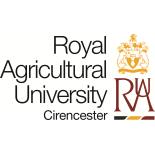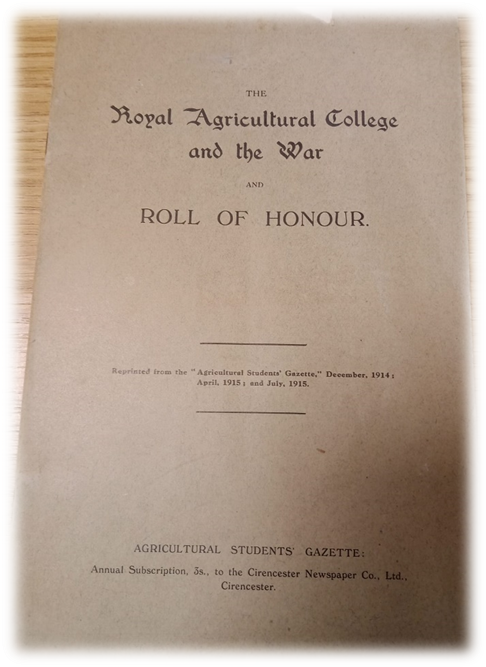The Royal Agricultural University during WWI: two inspirational stories
An elderly woman, not far away, wiped her eyes, and the man beside her looked white and stern … it was silence which was almost pain … and the spirit of memory brooded over it all.”
From the Manchester Guardian, 12th November 1919
World War I was one of the greatest disasters in the history of the world. It drew in 28 countries, and caused the deaths of around 21 million people. British Empire military fatalities amounted to 956,703.
With the threat of War in 1913, RAC/RAU student numbers began to drop. Staff and potential students were joining the Forces, and by 1914/15 there was a considerable loss of income. The financial situation was critical and it was suggested the College go into liquidation. £1,500 was eventually received from the Treasury’s Emergency Fund but in July 1915 it was still decided to close the College for the duration of the War and the staff were given notice to leave.
From 1914 to 1922 the Royal Agricultural College closed and the premises were used to house a girl’s school, Milton Mount College, that needed to be evacuated from the south coast. MMC was founded in 1873 for the education of the daughters of Congregational ministers and was designed to train its pupils as teachers.
The College re-opened with 56 students on 23rd October 1922. Fees were increased to £160 per annum for In-students and £85 per annum for Out-students. The fees for two students sharing a room remained at £150. The official re-opening was 12 April 1923, with a visit by Their Majesties King George V and Queen Mary who toured the buildings and farm and planted two Commemorative Trees.
In this blogpost we take a look at two students who enlisted and fought in the WWI.
Robert Smith-Barry, RAC student 1911-12
2nd Lt. Robert Smith-Barry (better known as pretty eccentric Bob Smith-B) was an old Etonian who went to the RAC, 1911-12. In 1914, Smith-B was made 2nd Lt. in the 5th Squadron of the Royal Flying Corps (RFC). He had taken his pilot certificate while at the RAC in 1911 and at the Central Flying School he was so confident that they employed him as an instructor. He applied to aviation the same ardour he once had to being a concert pianist – practising 8 hours a day for 2 years.
In August 1914, Smith-B fell from 1,200 feet at Peronne in France while flying from a German advance. His mechanic was killed but he survived with two broken legs and narrowly escaped the German army by lying quickly in his hospital pyjamas in a horse-drawn cab. For the rest of his life he would limp with a stick.
Back home, Smith-Barry became a Commander in the Royal Flying Corps where he was appalled at the poor pilot training: ‘They’ve only 7 hours flying, sir, it’s bloody murder’. 1 He refused to send anyone out until they’d reached a certain standard and when the RFC Commander visited, Smith-B ‘as good as told him he was a butcher.’
Smith-Barry wanted to start his own school for flying instructors. He believed that cautious, unadventurous pilot training was a danger in itself, leaving the trainee unprepared for emergencies. He was sure a pilot in training should always sit in the pilot’s seat and, not, as was then the case, in the passenger seat. Finally, Smith-B was made Head of the Gosport School of Flying and from there revolutionised flying training worldwide. ‘“The number of lives he saved,’ proclaimed Stanley Vincent, who later became his deputy, ‘is incalculable.
Smith-Barry died in May 1949 due to complications from surgery on his injured legs.
James John Kearney, of Gloucestershire Yeomanry, RAC student, 1913
JJ Kearney went to the RAC in 1913, after Dulwich College, London, and Downing College, Cambridge, which he entered in 1902. He was later a tenant farmer, possibly of the Gloucestershire-based Cripps family. During World War I, Kearney was a Trooper and his Yeomanry Division were sent dismounted to Suvla on the Gallipoli peninsula as reinforcements during the Battle of Sari Bair. “Advancing in the open across the dry Salt Lake on 21 August 1915, his landlord reputedly ‘asked if he was able to pay anything towards his rent. “Jimmy” answered no – killed in action that day, aged 31’
We wanted to share these two inspirational stories and remember our RAC/RAU staff and governors who were killed in action during WWI. There is no doubt that their contributions have never been forgotten and played a significant role in shaping the identity of modern Britain.
We have put together also a poignant display in the University Library to mark the Remembrance Day.
Sources:
The Royal Agricultural College and the War and Roll of Honour Agricultural Students’ Gazette
Barker Ralph The Royal Flying Corps in France Constable, 1994
https://en.wikipedia.org/wiki/Robert_Smith-Barry
https://livesofthefirstworldwar.iwm.org.uk/lifestory/221475
https://www.bbc.co.uk/news/uk-england-21321362
https://www.dow.cam.ac.uk/node/343












